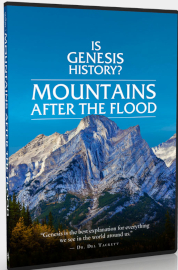A few years ago, I reviewed the documentary titled Is Genesis History? which provides an overview of creation science. This sequel, subtitled Mountains after the Flood, focuses more narrowly on geology.
A team that includes the geologists Dr. Andrew Snelling and Dr. John Whitmore takes a river-raft trip through the Grand Canyon to explore evidence regarding the canyon’s creation and the geological timetable. Del Tackett, the host of the series, helps viewers understand what they discover from a layman's point of view.
While many evolutionists explain the gradual formation of the Grand Canyon as having taken place over a long time, creationists look at it and see connections to a worldwide flood and catastrophic changes in the earth that would have caused its formation in a short time. Within the flood model, the same geological explanations for this area apply to other areas, even the formation of the Himalayan Mountains on the opposite side of the world.
In this video, geologists Snelling and Whitmore, along with other scientists working off-site, investigate a hypothesis concerning the formation of the layers of the Grand Canyon. While they make several observations, they are looking particularly at the “folds” in the rock layers where there are clear interruptions in the smoothness of the layers, bending before continuing on smoothly.
The scientists examine the composition of the rocks at the points where they are folded in comparison to points where the same layer is smooth. They examine extremely thin slices (known as “thin sections”) from different layers to determine their composition. For example, they take samples from a flat spot in the Tapeats Sandstone layer and then from Carbon Canyon fold, located about five miles away, but which is in the same Tapeats Sandstone layer. The goal is to explore the sandstone’s composition to better understand how it could have folded smoothly at about a 90-degree angle in the Carbon Canyon fold. Evolutionists claim that the layers were laid down hundreds of millions of years before the folding events took place. Yet the rocks would not have folded without crumbling and breaking (as you would expect) unless heat and pressure were applied simultaneously. However, metamorphic heat and pressure would have changed the composition of the folded rock in a way that would show up microscopically. The various rock "thin sections" prove to be indistinguishable. Had the rocks been exposed to heat and pressure, they would have looked extremely different under the microscope. According to the scientists, the folding must have happened a short time after the layers were deposited while there was still residual water within the layers to allow them to fold smoothly. The geologists applied the same process to samples from other layers of rock in the canyon and found the same results.
Another observation they make is that a sliver of rock from the Coconino sandstone in the Grand Canyon contains ooids. Ooids are created by sand grains rolling around in water and collecting a mineral around them (in this case, the mineral dolomite). This is a well-known process that happens only underwater. Such evidence lends credence to the idea that the layers were deposited by a flood.
As the video explains, all of this means that the layers were formed before huge mountain ranges were raised up, and folds occurred in the layers that still retained some water in the Grand Canyon and elsewhere around the world.
The geologists also comment that most canyons and valleys have rivers running through them, but the rivers in cases like the Grand Canyon are not large enough under normal circumstances to carve out the canyon. The eruption of Mt. St. Helens provides further evidence to support the creation of deep canyons in a very short period under catastrophic conditions.
Summary
Arguments between evolutionists and creationists are usually over how to interpret the evidence. But as more and more scientific evidence challenges evolutionary explanations, creationist models are looking increasingly credible.









